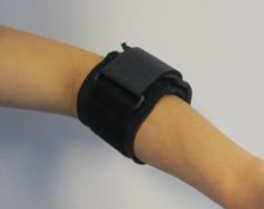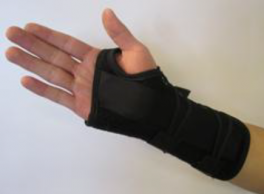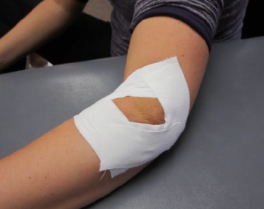Lateral Epicondyle Tendinopathy Toolkit: Section H - Braces, Splints, and Taping: Difference between revisions
Evan Thomas (talk | contribs) No edit summary |
Evan Thomas (talk | contribs) No edit summary |
||
| Line 1: | Line 1: | ||
== Counterforce Brace == | == Counterforce Brace == | ||
<br> | {| cellpadding="2" border="1" style="border: 1px solid darkgray;" | ||
|- | |||
| width="500" | | |||
*Counterforce braces are often used for pain relief in LET. | |||
*They are thought to diffuse the load through the tendon to less sensitive areas, thereby decreasing the stress on the area of pathology. | |||
*A combined cadaveric and clinical study showed a 13-15% force reduction of the ECRB origin with the counterforce brace (Meyer et al 2003<ref>Meyer NJ, Walter F, Haines B, Orton D, Daley RA. Modeled evidence of force reduction at the extensor carpi radialis brevis origin with the forearm support band. J Hand Surg [Am] 2003; 28:279-87.</ref>).<br> | |||
== Wrist Splint == | <br> | ||
.. | |||
<br> | |||
<br> | |||
<br> | |||
<br> | |||
| width="300" | | |||
[[Image:LET Appendix E Fig1.png|center|264x230px|Fig 1 of LET App E]]''' Figure 1''' | |||
|} | |||
<br> | |||
== Wrist Splint == | |||
{| cellpadding="2" border="1" style="border: 1px solid darkgray;" | |||
|- | |||
| width="500" | | |||
*Wrist splints are less commonly used, but do have some support for temporary pain relief in more acute patients. | |||
*The goal is to rest the musculotendinous unit originating at the lateral epicondyle.<br> | |||
<br> | |||
<br> | |||
<br> | |||
<br> | |||
<br> | |||
<br> | <br> | ||
== Diamond Taping Technique (Vicenzino et al 2003) == | | width="300" | | ||
... | [[Image:LET Appendix E Fig2.png|center|264x230px|Fig 2 of LET App E]]''' Figure 2''' | ||
|} | |||
<br> | |||
== Diamond Taping Technique (Vicenzino et al 2003<ref>Vicenzino B, Brooksbank J, Minto J, Offord S, Paungmali A. Initial effects of elbow taping on pain-free grip strength and pressure pain threshold. Journal of Orthopaedic & Sports Physical Therapy. Jul 2003; 33(7): 400-7.</ref>) == | |||
{| cellpadding="2" border="1" style="border: 1px solid darkgray;" | |||
|- | |||
| width="500" | | |||
*This taping technique consists of four tape strips, repeated twice. | |||
*The tape is laid in a diamond shape while pulling the soft tissues centrally towards the lateral epicondyle. | |||
*The goal is to decrease tension at the epicondyle attachment.<br> | |||
| width="300" | | |||
[[Image:LET Appendix E Fig3.png|center|264x230px|Fig 3 of LET App E]]''' Figure 3''' | |||
|} | |||
<br> | <br> | ||
Revision as of 01:03, 14 August 2013
Counterforce Brace[edit | edit source]
|
Figure 1 |
Wrist Splint[edit | edit source]
|
Figure 2 |
Diamond Taping Technique (Vicenzino et al 2003[2])[edit | edit source]
|
Figure 3 |
References[edit | edit source]
- ↑ Meyer NJ, Walter F, Haines B, Orton D, Daley RA. Modeled evidence of force reduction at the extensor carpi radialis brevis origin with the forearm support band. J Hand Surg [Am] 2003; 28:279-87.
- ↑ Vicenzino B, Brooksbank J, Minto J, Offord S, Paungmali A. Initial effects of elbow taping on pain-free grip strength and pressure pain threshold. Journal of Orthopaedic & Sports Physical Therapy. Jul 2003; 33(7): 400-7.









